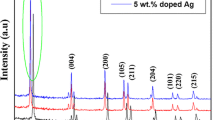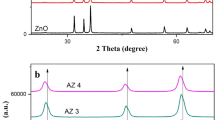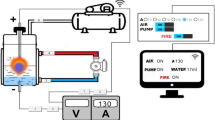The thermally and chemically stable TiO2 nanoparticles possessing a wide bandgap and a low toxicity are the most frequently used photocatalysts for decomposition of organic substances. However, a high rate of recombination of electron-hole pairs and a high energy of photoactivation significantly limit their applications. Modification of TiO2 with silver promotes surface charge separation and increases their photochemical activity. In the present study, the TiO2–Ag bicomponent nanoparticles are prepared by an electric explosion of metal wires in the atmosphere of 85 vol.% Ar – 15 vol.% O2. This method demonstrates a high production rate (170–200 g/h) quite sufficient for their large-scale manufacturing. However, electroexplosive nanoparticles are mostly agglomerates having sizes within 200–500 nm, which significantly reduces their photochemical activity in the test decomposition reaction of the model dye methylene blue under the visible light. It is shown that an ultrasonic treatment of the TiO2–Ag nanoparticles in an aqueous suspension for 15 min provides a 10% increase in their photochemical activity.
Similar content being viewed by others
References
X. Li et al., J. Environment. Chem. Eng., 9, No. 5, 106133 (2021).
S.U. M. Khan, Science, 297, No. 5590, 2243 (2002).
H. Razavi-Khosroshahi, J. Mater. Chem. A, 5, No. 38, 20298 (2017).
Q. Wang, Separation and Purification Technology, 211, 866 (2019).
Y. Cho et al., Nano lett., 18, No. 7, 4257 (2018).
A. Y. Vakhrushev et al., J. Porous Mater., 28, No. 4, 1023 (2021).
D. Negoescu et al., Multidisciplinary Digital Publishing Institute Proceedings, 57, No. 1, 60 (2020).
S. Abbad et al., J. Environment. Chem. Eng., 8, No. 5, 103718 (2020).
Y. X. Dong et al., Renewable Energy, 135, 1207 (2019).
O. V. Bakina et al., J. Mater. Sci.: Mater. Electron., 32, No. 8, 10623 (2021).
N. V. Svarovskaya, O. V. Bakina, A. V. Pervikov et al., Russ. Phys. J., 62, No. 9, 1504 (2019).
M. I. Lerner, Fizika Khim. Obr. Mater., No. 3, 73 (2016).
Stae Diagrams of Bimetallic Systems: reference book, Vol. 1 (Ed. N. P. Lyakishev) [in Russian], Mashinostroyeniye, Moscow (1996).
M. I. Lerner et al., Powder Technol., 288, 371 (2016).
M. I. Lerner et al., Inorgan. Mater.: Appl. Res., 8, No. 3, 473 (2017).
Author information
Authors and Affiliations
Corresponding author
Additional information
Translated from Izvestiya Vysshikh Uchebnykh Zavedenii, Fizika, No. 9, pp. 3–7, September, 2022.
Rights and permissions
Springer Nature or its licensor (e.g. a society or other partner) holds exclusive rights to this article under a publishing agreement with the author(s) or other rightsholder(s); author self-archiving of the accepted manuscript version of this article is solely governed by the terms of such publishing agreement and applicable law.
About this article
Cite this article
Bakina, O.V., Svarovskaya, N.V., Chzhou, V.R. et al. Application of Ultrasonic Treatment for Increasing the Photochemical Activity of TiO2–Ag Electroexplosive Bicomponent Nanoparticles. Russ Phys J 65, 1419–1423 (2023). https://doi.org/10.1007/s11182-023-02785-8
Received:
Revised:
Published:
Issue Date:
DOI: https://doi.org/10.1007/s11182-023-02785-8




